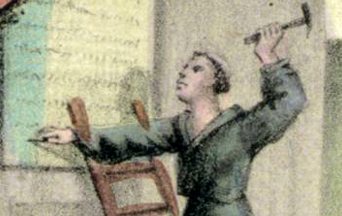
Every revolution needs legends to capture the imagination of its followers. It needs some act of defiance in which a major character charges into the mouth of the lion and plants his manifesto for all to see.
Such is the case of the October 31 commemoration of the five hundredth anniversary of Luther’s nailing of his 95 Theses to the door of the Castle Church in Wittenberg. All over the world, people are marking the day with portrayals and reenactments of the event. The only problem is that it appears that Luther never nailed the document to anything. The defiant act never happened.
 Learn All About the Prophecies of Our Lady of Good Success About Our Times
Learn All About the Prophecies of Our Lady of Good Success About Our Times
On October 31, Luther mailed, not nailed, his 95 theses to the Archbishop of Mainz and the Bishop of Brandenburg. Only one of the original two letters is still extant. The 95 theses, which he enclosed, have also faded into history since there are no existing copies of the original document (and therefore no verifiable nail holes). There is no record of any open and raging debate on the document in Wittenberg supposedly triggered by the non-event of its church-door nailing.
The legend of the nailing comes from an account of a disciple, Philipp Melanchthon, who could not have been an eyewitness to the event since he was not in Wittenberg at the time. His account was written well after Luther’s 1546 death.
It appears that the legend was embellished with time. Georg Roer, a friend of Luther, has him nailing theses, not to one but several church doors. Like Melanchthon, he also was not in Wittenberg at the time, and more than likely was drawing on Melanchthon in his account. The heresiarch Luther never mentioned this crowning act of defiance at any time during his lifetime.
Even the noisy act of nailing was uncertain. Willi Winkler, a Luther biographer, doubts the nailing took place but does acknowledge the legend. He noted that during the first centenary of the non-event in 1617, the instrument remembered was a simple feather pen which Luther used to write on the cathedral door. Apparently, the hammer was not part of the legend at the time and was added in later commemorations for dramatic effect.
The legend of the nailing was brought to light by Catholic researcher Erwin Iserloh in 1961. He pointed to the lack of primary sources or eyewitnesses to the nailing claim. Since then, many scholars, including Lutherans, have admitted the improbability of the nailing.
While the debate still simmers, the real issue is the use of legend to promote a revolution.
Historical legends have always existed that tend to embellish reality or highlight qualities of major figures. Heroes often appear larger than life because of their great projection and impact upon a people. However, such portrayals are usually based on some elements of truth that become embellished with age. The legend of El Cid in Spain builds upon the historical figure and recounts his exploits. These legends tend to cultivate a love of virtue, social harmony and heroism.
With the dawn of the modern age, revolutionaries have always skillfully used legendary figures to pursue their goals. However, unlike heroic figures or epic tales, these depictions often consist of fabrications made to fit a narrative of class struggle. Such revolutionary deeds never happened, but they are made to capture the imagination of “the masses.” These myths are then repeated continuously and become part of popular history.
Such is the case of Luther’s nailing of the 95 theses. Despite the lack of proofs, the story of the nailing is constantly repeated as a proof of Luther’s bold act of defiance to the Church. His disjointed and empty musings about the Church are elevated to the status of “theses.”
All this cloaks the real tragedy of the Lutheran revolt that split Christendom asunder. The non-event of October 31, 1517, was an empty and false gesture that marked the beginning of the catastrophic process of revolutions and divisions that would later follow.

